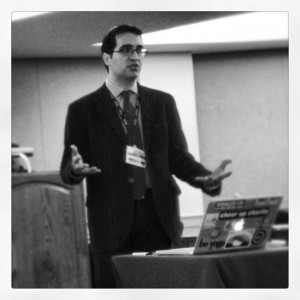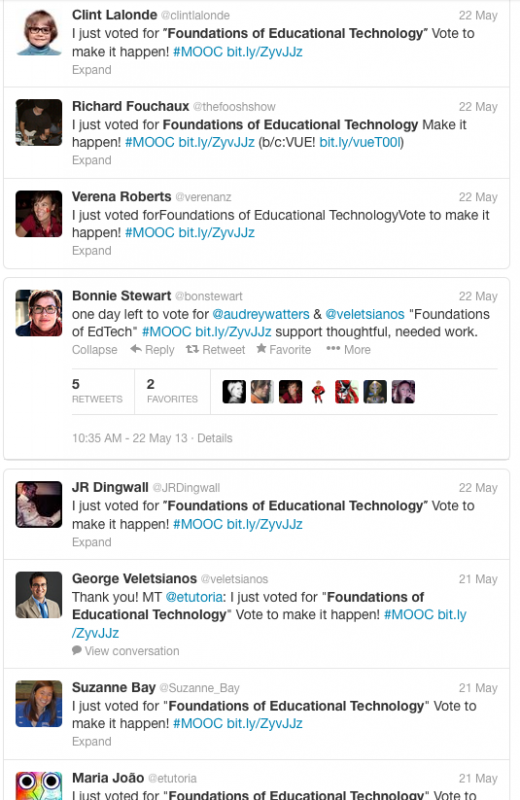Even though the concept of the Massive Open Online Course has become wildly popular during the last year, empirical research on these initiatives is largely absent.
On the one hand, this is not surprising. The fact that the research that exists in the literature falls under the case study approach is not surprising either. Historically, the research that characterizes emerging practices has been formative and focused on specific case studies (Dede, 1996). Research on connectivist MOOCs is available (e.g., see Fournier’s and Kop’s work), but research on other types of open courses is just slowly starting to emerge (e.g., see the work of the Lytics Lab and the research pertaining to P2PU). I hope and expect that a forthcoming special issue from JOLT focusing on MOOCs will add much needed insight.
The important questions that I believe we should be asking at this point are: What education-specific research will be beneficial to the field? What do we need to know? And how should we go about investigating what we need to know about? Systematic empirical research can (a) generate a deeper understanding of this phenomenon, (b) provide evidence to support or refute the claims surrounding MOOCs, and (c) help universities and MOOC providers enhance course offerings.
What follows is a set of research questions that, if answered, will generate insights into learner/instructor experiences, outcomes, practices, and interaction in massive open online learning courses:
- What are the learning outcomes of MOOCs?
- Who successfully completes MOOCs? What are the shared characteristics of the individuals who successfully complete MOOCs? For instance, past research shows that there’s a strong positive relationship between prior knowledge and learning (Dochy, Segers, & Buehl, 1999). It would not be a stretch to expect this to transfer to MOOCs.
- Why do learners sign-up for MOOCs? Note that this is an empirical question. We can surmise why they do, but asking them may yield different answers… or may bolster what we already think we are seeing.
- What factors cause learners to persist or cease participation in MOOCs? The concepts of “dropping out” and “retention” are not new (e.g., The Chronicle of Higher Education wrote a story in 2000 that was entitled “As Distance Education Comes of Age, the Challenge Is Keeping the Students“), have already been examined in the broader online learning literature (e.g., Park & Choi, 2009), and a number of models exists to explain dropout (e.g.,Bean & Metzner, 1985). Recent evidence highlights that academic locus of control and self-regulation are factors that mediate persistence in online learning (Lee, Choi, & Kim, 2013). However, the concept of “drop out” has historically been associated with for-credit endeavors. With large numbers of individuals seemingly enrolling in MOOCs out of sheer interest and curiosity, and perhaps merely exploring their options, what new knowledge can we gain about this issue? Koller, Ng, Do, and Chen (2013) add nuance to this discussion by adding the idea that “student intent” is important in this discussion, which I think is worthwhile. However, even with this variable in mind, we should still ask: What factors cause learners to persist or cease participation? Intent can be defined ex post facto by looking at the coursera data, but intent changes over time. For example, one may sign up for a course intending to complete it, but for various reasons (e.g., unrealistic expectations, lack of time, bad course design) may cease participation. Conversely, one may sign up for a course to simply explore a topic but may stay (e.g., a supportive community encourages ongoing participation).
- What is the learning experience like in a MOOC? How does this experience differ across designs and pedagogical models?
- How do learning communities and groups develop, grow, and dissipate in MOOCs, in both online spaces (e.g., Facebook groups) and face-to-face spaces (e.g., mediated by Meetups)?
- What factors are critical in sustaining learner interest, motivation, and participation in a MOOC?
A number of initiatives are in place at present to examine MOOCs. For example, HarvardX has established a research committee headed by Andrew Ho, a professor of education, to conduct research on EdX; Justin Reich is joining the HarvardX team as a Research Fellow; George Siemens, Valerie Irvine, and Jillianne Code are editing a special issue focused on MOOCs for the Journal of Online Learning and Teaching (pdf); and the Journal of Universal Computer Science is also hosting a special issue focused on Interaction in MOOCs (pdf). Such initiatives will go a long way in providing much needed empirical results on the topic.
References
Dede, C. (1996). Emerging technologies and distributed learning. American Journal of Distance Education, 10(2), 4-36.
Dochy, F., Segers, M., & Buehl, M. (1999). The relation between assessment practices and outcomes of studies: The case of research on prior knowledge. Review of Educational Research, 69, (2), 145-186.
Lee, Y., Choi, J. and Kim, T. (2013), Discriminating factors between completers of and dropouts from online learning courses. British Journal of Educational Technology, 44(2), 328–337.
Park, J.-H., & Choi, H. J. (2009). Factors Influencing Adult Learners’ Decision to Drop Out or Persist in Online Learning. Educational Technology & Society, 12 (4), 207–217.




